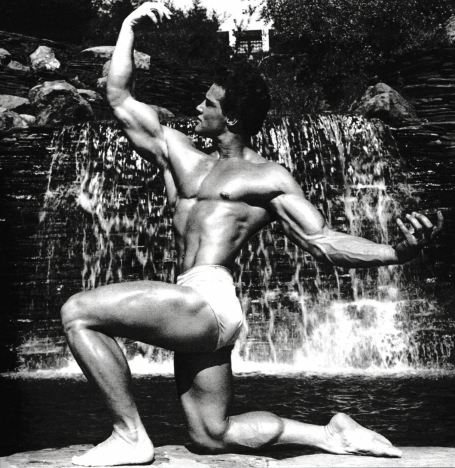Many lifting at home feel that equipment is too limited. If serious about training, this leads to despair that you’ll achieve much progress.

However, everything changes once you realize that bodybuilding is about the right muscle actions, not special positions, strength curves or ranges of motion.
You understand that free weights can hit all muscles with some creativity. A power or half rack, bench, weight plates, barbell or adjustable dumbbells, and overhead bar will provide more than everything required.
Many assume they must drop the leg curl upon training at home without a machine, perhaps resigning themselves to pure hip extension through say a stiff-legged or Romanian dead-lift.
This isn’t true!
Leg curls can easily be performed at home, and with heavy weight if done properly, while having unique value.
For the muscles worked, knee flexion emphasizes the semitendinosus of the hamstrings. The leg curl is necessary for hitting the biceps femoris short head.
(In research, the Nordic hamstring exercise is just closed-chain knee flexion, though most of us lack enough strength to make this a good option.)
The leg curl hits other muscles like the sartorius & gracilis toward a balanced lower body, developing inner thigh girth without unappealing turnip-shaped thighs as lamented by Steve Reeves.
This complements pure or countercurrent hip extension, which is dominated by the biceps femoris long head and semimembranosus. This requires an exercise like a hyperextension or a glute-ham raise device instead of a compound squat or leg press.
Though some research shows the leg curl hits the biceps femoris well too, hip extension still uniquely develops the glutes, and these exercises also tend to work the lower back.
Despite these benefits, trainees struggle to use a heavy weight during lying dumbbell leg curls. Without this capability, it will never become a serious exercise. Consider these tips to make it worthy.
Table of Contents
- Establish a strong grip with your feet around the plate or bell.
- Use a flat bench instead of a decline bench.
- Hold a stable object with your hands.
Establish a strong grip with your feet around the plate or bell.
While lying prone on the bench, you’ll cross-cross your feet around the inner side of an Olympic plate or fixed bell for either dumbbell type, establishing a firm grip.
Without a bench, you won’t obtain a range of motion allowing enough power if done from the floor instead.
Use small fixed bells or 5 lb. plates as the max size for Olympic dumbbell handles. This allows your feet to wrap around the plate. Otherwise, there’s a tendency for the plates to slip off when larger. Shoes like Chuck Taylor’s can facilitate this further.
Keep your soles toward the ceiling. Pointing your feet, which changes the length of the gastrocnemius in the leg, makes little to no difference in the leg curl. Despite attaching to the knees, this calf muscle has such poor leverage that it plays a minor role here.
Use a flat bench instead of a decline bench.
This is the most important tip!
Using a decline bench is well-intentioned but flawed.
Since the hamstrings attach to both the hips and the knees, modern leg curl machines have angled benches for the upper and lower body portions. This flexes the hips. This prevents active insufficiency due to the muscle becoming too shortened as knee flexion increases.
However, with free weights, the very top fails to overload the hamstrings, since no angle opposes gravity that acts purely downward.
Without a cam from a machine, the hamstrings actually overload most when the knees are fully extended yet shortened at the hips. This is a strong, medium position for myofilaments at the microscopic level to bind.
This tip is essential because a decline bench will have the weights likely to slip off your feet, especially near or at the bottom of the motion.
Finally, I definitely suggest against a Swiss or stability ball, which fails to allow enough steadiness.
Hold a stable object with your hands.
Placing the flat bench within a power rack and grabbing the uprights, or holding a heavy bench itself when separate from a setup, lets you to exert the most force and without focusing on counterbalancing the dumbbell.
Keep It Simple with Lying Dumbbell Leg Curls
Don’t invest in a cheap leg extension/leg curl combination machine or anything fancy like special boots until you try proper leg curl form described here.
All leg curl machines, in the end, are simply more convenient.
Though some research shows that different hamstrings moment arms could indicate that each muscle gets overloaded more or less throughout the range of motion, I feel that standing, seated & lying leg curl machines ultimately address them all about the same.
Lower body training at home can be more challenging but just as effective if given some thought. Sissy squats, lying dumbbell leg curls, one-legged straight & bent heel raises, and sit-ups alongside stiff-legged dead-lifts will totally develop all the major lower body muscles.
There are some other creative leg curl possibilities, like placing one end of a barbell in a corner, then curling up the other end a single leg at a time. I ultimately feel the lying dumbbell leg curl works best though.
Never feel limited by training with basic equipment, at home or otherwise. Using proper form on lying dumbbell leg curls makes this bodybuilding movement accessible and effective for everyone. Give it a try!
